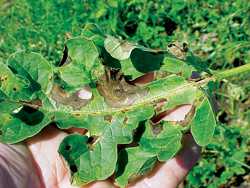Gummy Stem Blight

Gummy stem blight is known to some as the most feared disease of watermelon. Why? Because of its ability to spread rapidly through the field.
David Langston, an associate professor in the plant pathology department at the University of Georgia, says growers have told him that they’ll inspect their field one day and then in two days virtually all plants are ruined — thanks to the fungus, Didymella bryoniae, which causes gummy stem blight.
And for those who think a remedial treatment will work after an outbreak begins, think again. Langston says remedial treatments following an outbreak have very little effect on the disease.
Ideal Conditions
Gummy stem blight occurs in hot, wet weather. Specifically, Langston says the best conditions for an outbreak are temperatures in the mid-80s and above with relative humidity greater than 95%. “Rainfall really gets it going,” he adds.
The disease can attack all parts of the plant, but Langston says it typically is seen on the stems and leaves. For growers who don’t catch it in time, they can lose up to 100% of the watermelon in their fields. In some instances, he says growers lose their crop because they were using the wrong fungicide or they were spraying with a fungicide that wasn’t working.
Transplant Trouble
The weather isn’t the only factor that facilitates this disease. Seed can also be a problem.
Most watermelon seeds come from Asia and South America. They are produced in areas where the disease “supposedly” has not occurred, says Langston. What makes him skeptical is that there are many instances where gummy stem blight shows up on greenhouse-grown transplants.
The disease also can overwinter in infested seed and come back the next year on volunteer watermelon. It can also spread on ascospores in the spring through air dispersal.
“Once it gets started in a field, it spreads by rain splash or it can be spread by people or machinery,” says Langston. “In the field, the spores stick to things very easily and can be transported.”
Because gummy stem blight can be spread via infected transplants and by rain splash, it is both an airborne and a seedborne disease. “But I think it is important to know where the inoculum is coming from,” he adds. “It is a whole lot easier to deal with if you know the source of the primary inoculum.”
How do growers determine the source of inoculum? Langston says in Georgia, the Number Two state for watermelon production in the U.S., growers follow cultural practices such as plant rotation and deep turning soil. “And we check transplants for gummy stem blight,” he adds.
When this pest has been confirmed in the field, Langston tells growers to reduce the leaf wetness period. “Most growers overhead irrigate and I tell them to schedule irrigation first thing in the morning so the leaves will dry as they would if they had a heavy dew.”
Grower Tools
A number of fungicides can be used on this disease, but there is a risk of developing resistance. To avoid resistance, Langston tells growers to rotate products and use broad spectrum fungicides as much as possible. An example of a primary broad spectrum fungicide is chlorothalonil (Bravo, Syngenta Crop Protection). Several generic chlorothalonil products such as Echo (Sipcam Agro USA, Inc.) or Equus (MANA Crop Protection) are available, as well.
Langston suggests rotating chlorothalonil with triazole fungicides such as Folicur (tebuconazole, Bayer CropScience) or the generic tebuconazole. He also suggests rotating products with Topsin M (thiophanate-methyl, United Phosphorus, Inc.) and mancozeb (Dithane, Dow AgroSciences) at high rates.
In addition to these products, Langston says additional tools may be coming. Another fungicide from Syngenta Crop Protection may soon receive a label for gummy stem blight, and a new product from Bayer CropScience is expected to be registered this fall. These fungicides, he says, are effective where “we see resistance to strobilurins and and where we see resistance to the carboxamide fungicides.”









